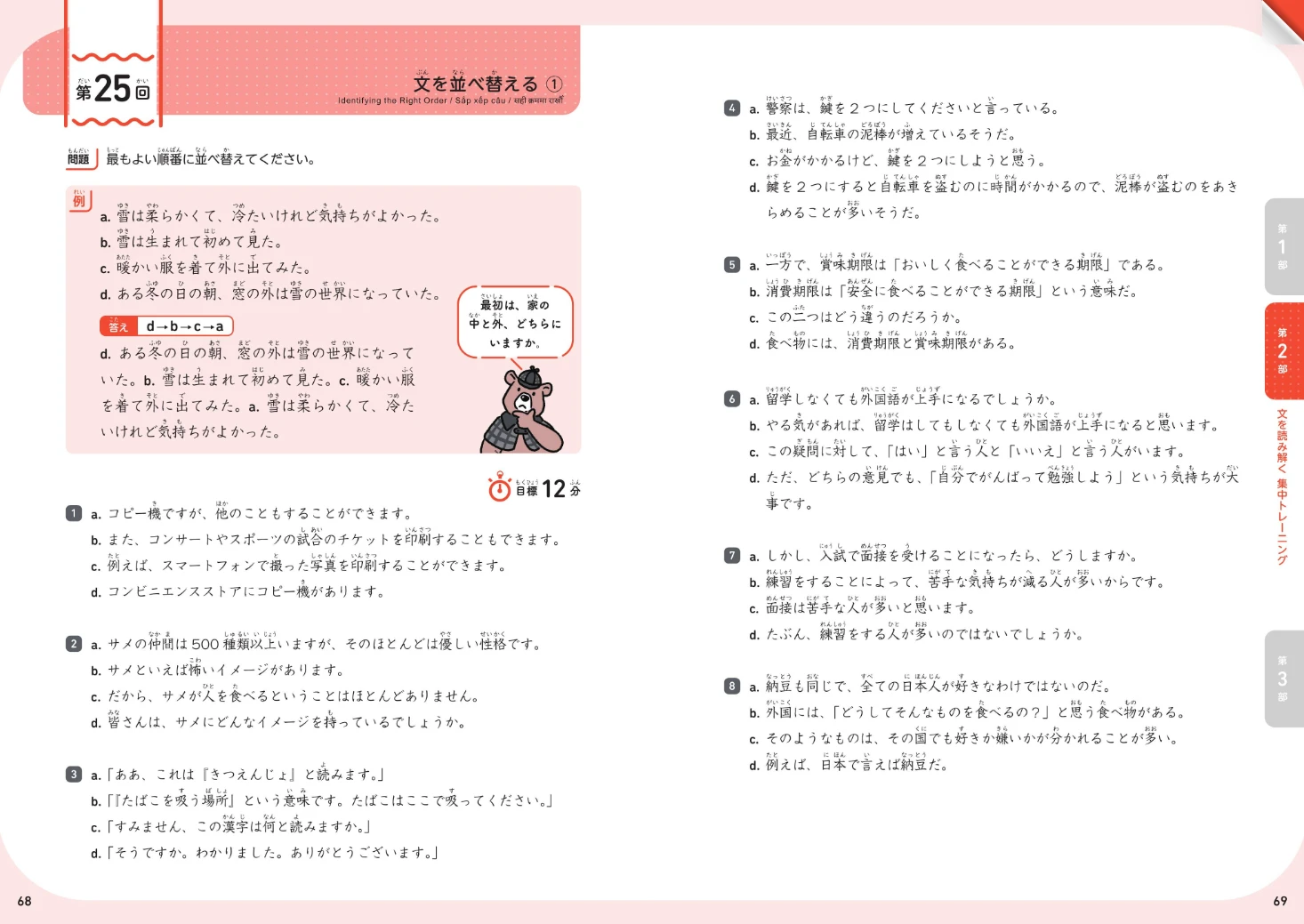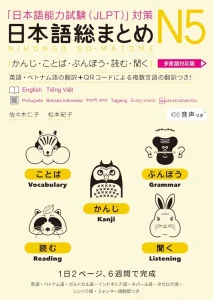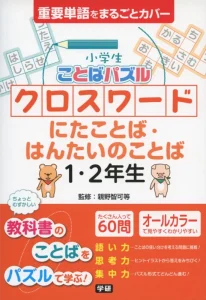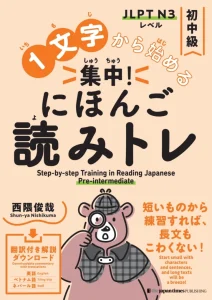Step-By-Step Training in Reading Japanese: Pre-Intermediate
1文字から始める 集中!にほんご読みトレ 初中級
Before ReadingStep-By-Step Training in Reading Japanese is designed for learners who have finished the beginner level and are able to speak Japanese but struggle with reading sentences. It offers a structured approach progressing from one character to one sentence, then one paragraph, helping learners master how to read Japanese correctly. The content uses grammar and vocabulary at the JLPT N3 level, making it ideal for those aiming to strengthen their basic reading skills in preparation for the test.
Even better, the publisher provides a downloadable PDF on their website with all the answers. What makes it stand out is how detailed the explanations are. Instead of simply listing the correct responses, the guide walks you through why each answer is correct. That kind of insight is rare in Japanese textbooks and is especially valuable for anyone studying on their own.
If you’re curious, give the book’s official website a look! Step-By-Step Training in Reading Japanese official site.

What does Step-By-Step Training in Reading Japanese: Pre-Intermediate cover?
The book is divided into three main parts, each building on the last to strengthen your reading skills step by step.
Part 1 – Basic Training: Starting with One Character
This section lays the groundwork. You’ll practise spotting the odd one out, catching small mistakes, and recognising subtle character differences. You’ll also learn how to interpret symbols and read simple tables. A great warm-up before tackling longer texts.
Part 2 – Intensive Training: Reading Sentences
Here, things start to get more interesting. The exercises focus on understanding sentence structure through the classic “5W1H” framework — who, what, when, where, why, and how. You’ll also paraphrase sentences, identify nuances in word usage, fill in blanks, and determine the correct word order. It’s excellent practice for building both accuracy and fluency.
Part 3 – Applied Training: Reading Passages and Information
Finally, you’ll put everything together. This section takes you into full-length reading tasks, where you’ll decipher paragraphs, organise information, and interpret different writing styles and contexts, just like in real exam conditions.
Student Review

One thing that really stands out about this book is how easy it feels at the start. Honestly, I thought I’d opened the wrong one at first! It begins with a kanji recognition test where you see a line of about 80 characters like ね, and your job is to spot the ones that don’t belong. In this case, there are two わ hiding among them.
It sounds simple enough, but what the book is really testing is your speed. Each task has a built-in timer, and it’s not about whether you know the characters, but how quickly you can find the right ones in an exam setting. You get 10 minutes for this first section, but I finished in about two. A nice confidence boost to start with.
But don’t get too comfortable. Next, you’re asked to spot incorrect radicals inside kanji — for example, finding 音薬 among a sea of 音楽. That’s still manageable depending on how much kanji you’ve studied, but it’s a good reminder to watch for small differences when skim reading. Something that can really help during the JLPT.
From there, things ramp up. You’ll be identifying shorter sentences within 10 minutes like:
トナムの料理の中で、何が一番好さですか。Then, in the next batch, you’ll be finding mistakes in eight longer pieces of text, again within 10 minutes:
"あしたから、スポーツセンターの利用時間が変わります。今まで午前9時から午後6時まででしたが、明日からは午前9時から午後8時までになります。会社が変わったあとにも来ることができます。どうぞご利用ください。"So, the difficulty does climb! Other tasks include hunting for small contextual errors, like spotting a stray です in a paragraph written in casual form. Finding words that don’t quite fit, and tackling that old IELTS-style challenge of matching sentences to the right charts or graphs.
And that’s just the first section of the book!
One part I found especially useful focuses on figuring out which clauses connect to which subjects within a sentence. In longer passages, it can be surprisingly tricky to tell who or what a sentence is referring to. This book gives you plenty of practice with that, helping you build the kind of reading accuracy that’s invaluable for higher-level comprehension tasks.
This is one of the best books for JLPT reading study. By the end of the book, you should easily be able to tell if you’re ready for the N3 exam or not.
A common weakness of Western students learning Japanese is that many aspects of the Japanese language, kanji, hiragana, grammar, and vocabulary, are taught separately and siloed into their own domains. This is understandable, as Japanese is a very different language from English and there is a lot to learn! However, by the time you reach around N3 level, it becomes really important to start connecting these areas. That’s how you move from understanding the parts to actually using the language naturally.
This book follows a clear progression, starting from individual characters, moving on to words written entirely in kanji, then to short sentences, longer passages, and finally to how sentences connect with other types of information or media.
Part 1 focuses on developing your scanning and recognition skills, training your eyes to move quickly and accurately across text. Part 2 then shifts closer to the kinds of tasks you’ll face in the JLPT, where you need to identify the subject of a sentence or choose which statement matches its meaning. Others involve finding sentences which would properly follow on after the example sentence. Just like in Part 1, the exercises build step by step, gradually introducing more complex rephrasing tasks to strengthen your overall reading comprehension.
Another useful section is one that tests students’ understanding of different pieces of grammar and particles. Can you accurately identify different uses of から in a list of sentences? While students at N3 level will surely understand the various uses, it’s quite common for them to still recall their favored use of the grammar, sometimes against context. These questions encourage them to slow down (but not too much!) and reconsider the context.
Teacher Review

Before using Step-By-Step Training in Reading Japanese: Pre-Intermediate:
Shin Kanzen Master N4 is a good choice for those who need a brush-up before taking their N3.
What to read next?
Once you finish this book, a good recommendation would be to read Yomu kara hajimeru nihongo kaiwa wākubukku for more hands-off reading practice.

Nihongo Sou Matome N5
Structure your study with Nihongo Sou Matome JLPT N5! Prepare for your exam with 6 weeks of planned grammar, listening, vocab and kanji study.

Elementary School Word Puzzle Japanese Crosswords
Boost your vocabulary with a fun Japanese crossword puzzle book! Written for Japanese kids it’s perfect for JLPT N5 learners and casual study.

Shin Kanzen Master JLPT N4 Reading Review
Effective JLPT N4 reading techniques with Shin Kanzen Master N4 Reading, how to understand sentence structure and more for successful reading comprehension.

